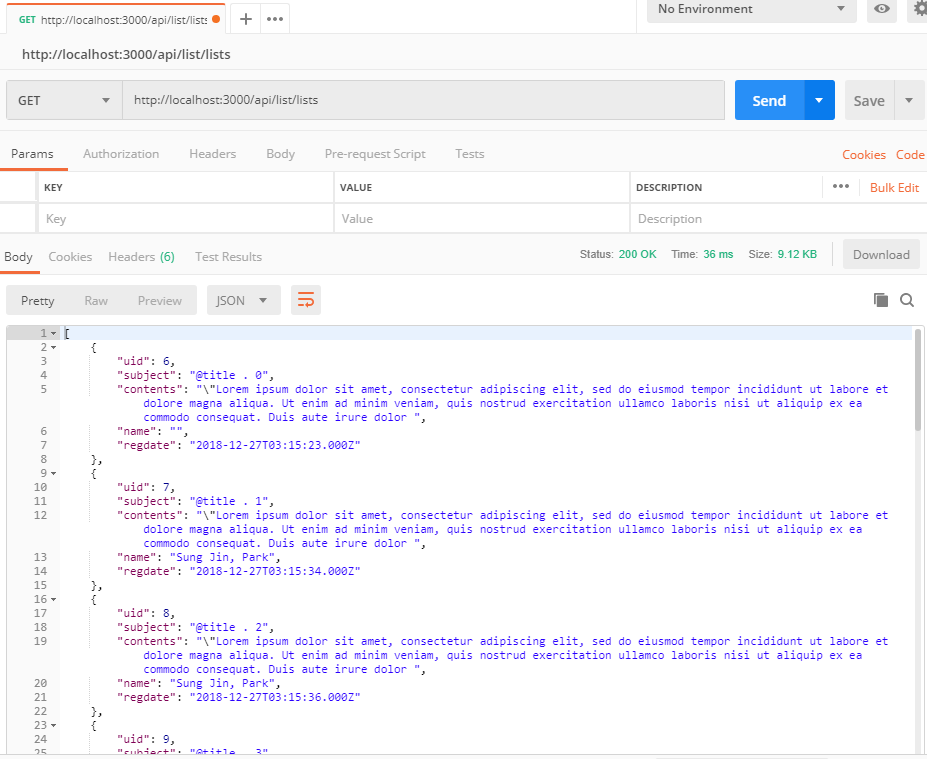TypeOrm (object Relational Mapping)
TypeORM 에서 ORM 기본, NativeScript, 박람회 및 전자 플랫폼 반응, NodeJS, 브라우저, 코르도바, 폰갭, 이온 성에서 실행할 수 있으며, 타이프 라이터와 자바 스크립트 (ES5, ES6, ES7, ES8)와 함께 사용할 수 있습니다. 이 솔루션의 목표는 항상 최신 JavaScript 기능을 지원하고 몇 가지 테이블이있는 소규모 응용 프로그램부터 여러 데이터베이스가있는 대규모 엔터프라이즈 응용 프로그램에 이르기까지 데이터베이스를 사용하는 모든 종류의 응용 프로그램을 개발하는 데 도움이되는 추가 기능을 제공하는 것입니다.
ORM 이란?
Object Relational Mapping, 객체-관계 매핑
- 객체와 테이블 시스템(RDBMSs)을 변형 및 연결해주는 작업이라 말 할 수 있다. ORM을 이용한 개발은 객체와 데이터베이스의 변형에 유연하게 대처할 수 있도록 해준다. ORM을 객체 지향 프로그래밍 관점에서 생각해보면, 관계형 데이터베이스에 제약을 최대한 받지 않으면서, 객체를 클래스로 표현하는 것과 같이 관계형 데이터베이스를 객체처럼 쉽게 표현 또는 사용하자는 것이다.
ORM 의 장단점
- 선언 , 할당 , 종료 같은 부수적인 코드가 없거나 급격히 줄어든다.
- 각종 객체에 대한 코드를 별도로 작성하기 떄문에 코드의 가독성을 올려준다.
- SQL 의 절차 , 순차적인 접근 방식이 아닌 객체 접근 방식이다.
- 완벽하게 ORM 서비스구현이 어려울수있다.
- 사용하기에 편리함은 있지만 설계가 복잡하다.
- 프로젝트 복잡성과난이도레따라 퍼포먼스의 큰차이가 있다.
TypeOrm 환경설정 및 사용법
-
데이터베이스와의 상호 작용은 일단 연결을 설정 한 후에 만 가능합니다. TypeORM Connection은 데이터베이스 연결을 설정하지 않고 연결 풀을 설정합니다.
1-1. CreateConnection
연결을 생성하는 방법에는 여러 가지가 있습니다. 가장 간단하고 일반적인 방법은 사용하는 것입니다 createConnection및 createConnections기능을합니다.
createConnection 단일연결 예제
import {createConnection, Connection} from "typeorm"; const connection = await createConnection({ type: "postgres", host: "localhost", port: 5432, username: "test", password: "test", database: "test" });1-2. CreateConnections 다중연결 예제
import {createConnections, Connection} from "typeorm"; const connections = await createConnections([{ name: "default", type: "mysql", host: "localhost", port: 3306, username: "test", password: "test", database: "test" }, { name: "test2-connection", type: "mysql", host: "localhost", port: 3306, username: "test", password: "test", database: "test2" }]);이 두 함수는 Connection전달하고 connect메서드를 호출하는 연결 옵션을 기반으로 만듭니다 . 프로젝트의 루트에 ormconfig.json 파일을 작성할 수 있으며 이러한 옵션을 사용하여 연결 옵션을 자동으로이 파일에서 읽을 수 있습니다.
1-3. 연결성공시 getConnection함수를 사용하여 앱에서 어디에서나 연결할 수 있습니다.
import {getConnection} from "typeorm"; const connection = getConnection(); const secondConnection = getConnection("test2-connection"); -
Entity는 데이터베이스 테이블 (또는 MongoDB를 사용할 때 컬렉션)에 매핑되는 클래스입니다. 새로운 클래스를 정의하여 Entity를 생성하고이를 다음과 @Entity()같이 표시 할 수 있습니다.
example
import {Entity, PrimaryGeneratedColumn, Column} from "typeorm"; @Entity() export class User { @PrimaryGeneratedColumn() id: number; @Column() firstName: string; @Column() lastName: string; @Column() isActive: boolean; }위와같은 코드를 입력 할 경우 다음과 같은 데이터베이스 테이블이 생성됩니다.
+-------------+--------------+----------------------------+ | user | +-------------+--------------+----------------------------+ | id | int(11) | PRIMARY KEY AUTO_INCREMENT | | firstName | varchar(255) | | | lastName | varchar(255) | | | isActive | boolean | | +-------------+--------------+----------------------------+기본 엔티티는 열과 관계로 구성됩니다. 각 엔티티는 반드시 (MongoDB를 사용중인 경우 또는 ObjectId가 열) 주 열을 갖는다. 각 개체는 연결 옵션에 등록해야합니다.
2-1. 연결옵션 설정
import {createConnection, Connection} from "typeorm"; import {User} from "./entity/User"; const connection: Connection = await createConnection({ type: "mysql", host: "localhost", port: 3306, username: "test", password: "test", database: "test", entities: [User] });또는 모든 Entity가 포함 된 디렉토리 전체를 지정할 수 있으며 모든 Entity가로드됩니다.
import {createConnection, Connection} from "typeorm"; const connection: Connection = await createConnection({ type: "mysql", host: "localhost", port: 3306, username: "test", password: "test", database: "test", entities: ["entity/*.js"] });2-2. 기본열
각 Entity에는 최소한 하나의 기본 열이 있어야합니다. 기본 열의 몇 가지 유형이 있습니다.
import {Entity, PrimaryColumn} from "typeorm"; @Entity() export class User { @PrimaryColumn() id: number; }@PrimaryColumn()모든 유형의 값을 취하는 기본 열을 만듭니다. 열 유형을 지정할 수 있습니다. 열 유형을 지정하지 않으면 특성 유형에서 유추됩니다. 아래 예제는 int저장하기 전에 수동으로 지정해야하는 유형으로 ID를 만듭니다.
import {Entity, PrimaryGeneratedColumn} from "typeorm"; @Entity() export class User { @PrimaryGeneratedColumn() id: number; }@PrimaryGeneratedColumn(“uuid”)값이 자동으로 생성되는 기본 열을 만듭니다uuid.Uuid는 고유 한 문자열 ID입니다. 저장하기 전에 값을 수동으로 지정할 필요가 없습니다. 값이 자동으로 생성됩니다
import {Entity, PrimaryColumn} from "typeorm"; @Entity() export class User { @PrimaryColumn() firstName: string; @PrimaryColumn() lastName: string; }Entity를 사용하여 Entity를 저장 save하면 항상 주어진 Entity ID (또는 ID)로 엔티티를 데이터베이스에서 찾습니다. id / id가 발견되면 데이터베이스에서이 행을 갱신합니다. id / ids 행이없는 경우 새 행이 삽입된다.
-
대부분의 경우 연결 옵션을 편리하고 관리하기 용이하게, 별도의 구성 파일에 저장하려고합니다. TypeORM은 여러 구성 소스를 지원하며, ormconfig.[format] 파일 을 만들고 createConnection()구성을 전달하지 않고 응용 프로그램 호출에 구성을 저장하기 만하면됩니다.
연결 방법
import {createConnection} from "typeorm";
const connection = await createConnection();
사용법ormconfig.json
{
"type": "mysql",
"host": "localhost",
"port": 3306,
"username": "test",
"password": "test",
"database": "test"
}
이것으로 typeorm 의 간단한 개념과 설정방법을 알아보았다.
예제
import { Entity, BaseEntity, PrimaryGeneratedColumn, Column } from 'typeorm';
@Entity()
export class User extends BaseEntity {
@PrimaryGeneratedColumn()
id: number;
@Column({
length: 20
})
name: string;
@Column()
age: number;
@Column()
date: Date;
}
import * as express from 'express';
import listCtrl from './list.controller';
const router = express.Router();
router.get('/lists', listCtrl.getList);
router.get('/insert', listCtrl.write);
export default router;
src/api/list/list.controller.ts
import { Request, Response } from 'express';
import { getRepository } from 'typeorm';
import { List } from 'entity/List';
class ListController {
// select
public getList = async (req: Request, res: Response) => {
try {
const list = await getRepository(List).find();
res.json(list);
} catch (e) {
res.state(404).json({message: e.message});
throw new Error(e);
}
}
// insert
public write = async (req: Request, res: Response) => {
const lists = await getRepository(List).find();
const list = new List();
list.subject = `@ title . ${lists.length}`;
list.contents = example,
list.name = 'Sung Jin, Park',
list.regdate = new Date()
try {
list.save();
res.json({ state: 200 })
} catch (e) {
throw new Error(e);
}
}
}
export default new ListController();
import * as express from 'express';
import user from './user';
import list from './list';
const router = express.Router();
router.use('/user', user);
router.use('/list', list);
export default router;
import routes from './api';
/* ... */
constructor () {
this.App = express();
this.App.use('/api', routes);
}
실행결과확인


